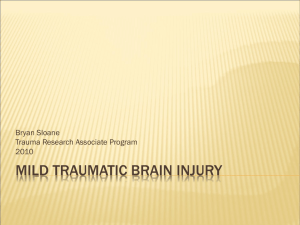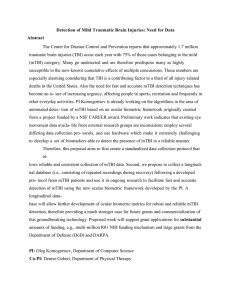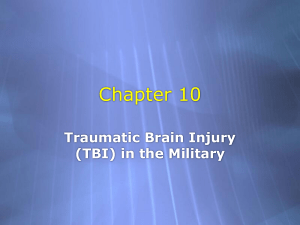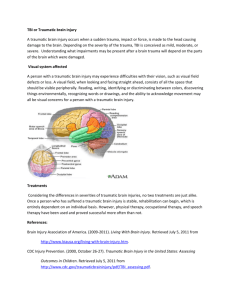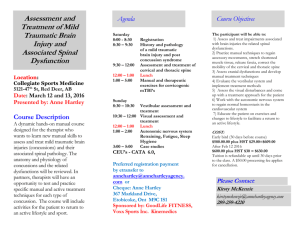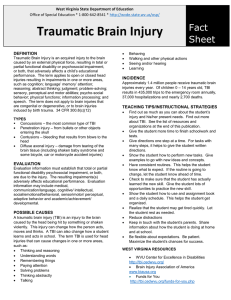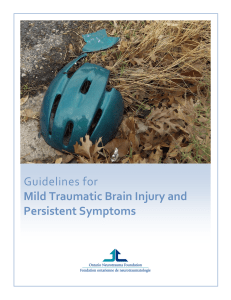I Mild Traumatic Brain Injury: A Silent Epidemic in Our Practices o
advertisement
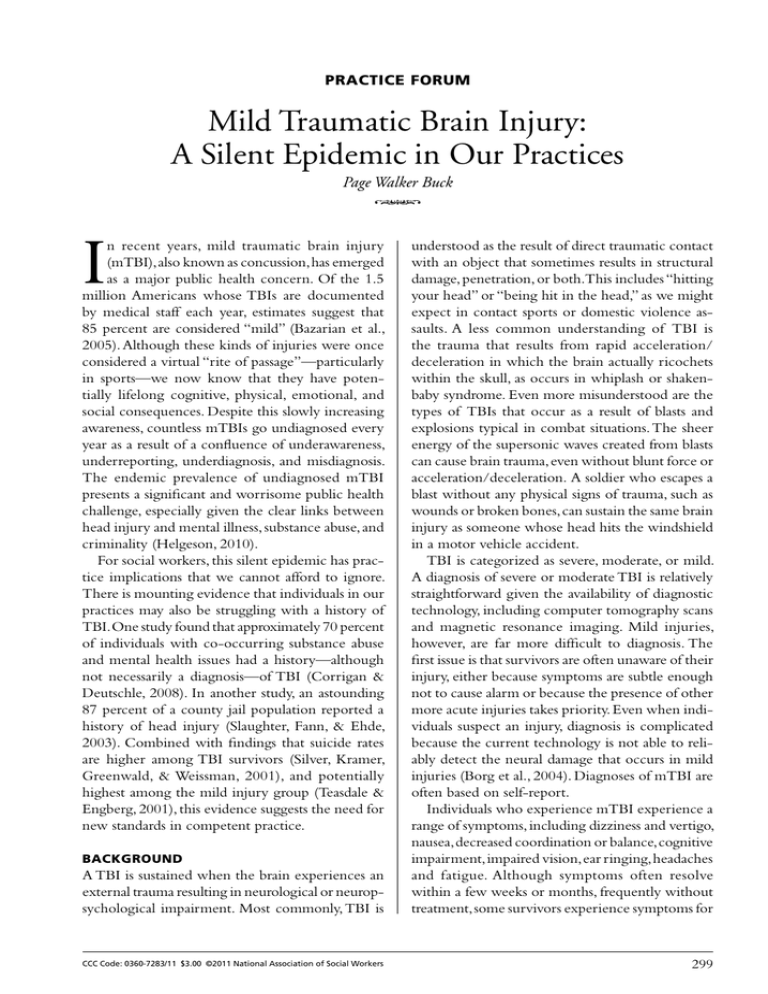
Practice Forum Mild Traumatic Brain Injury: A Silent Epidemic in Our Practices Page Walker Buck o I n recent years, mild traumatic brain injury (mTBI), also known as concussion, has emerged as a major public health concern. Of the 1.5 million Americans whose TBIs are documented by medical staff each year, estimates suggest that 85 percent are considered “mild” (Bazarian et al., 2005). Although these kinds of injuries were once considered a virtual “rite of passage”—particularly in sports—we now know that they have potentially lifelong cognitive, physical, emotional, and social consequences. Despite this slowly increasing awareness, countless mTBIs go undiagnosed every year as a result of a confluence of underawareness, underreporting, underdiagnosis, and misdiagnosis. The endemic prevalence of undiagnosed mTBI presents a significant and worrisome public health challenge, especially given the clear links between head injury and mental illness, substance abuse, and criminality (Helgeson, 2010). For social workers, this silent epidemic has practice implications that we cannot afford to ignore. There is mounting evidence that individuals in our practices may also be struggling with a history of TBI. One study found that approximately 70 percent of individuals with co-occurring substance abuse and mental health issues had a history—although not necessarily a diagnosis—of TBI (Corrigan & Deutschle, 2008). In another study, an astounding 87 percent of a county jail population reported a history of head injury (Slaughter, Fann, & Ehde, 2003). Combined with findings that suicide rates are higher among TBI survivors (Silver, Kramer, Greenwald, & Weissman, 2001), and potentially highest among the mild injury group (Teasdale & Engberg, 2001), this evidence suggests the need for new standards in competent practice. Background A TBI is sustained when the brain experiences an external trauma resulting in neurological or neuropsychological impairment. Most commonly, TBI is understood as the result of direct traumatic contact with an object that sometimes results in structural damage, penetration, or both.This includes “hitting your head” or “being hit in the head,” as we might expect in contact sports or domestic violence assaults. A less common understanding of TBI is the trauma that results from rapid acceleration/ deceleration in which the brain actually ricochets within the skull, as occurs in whiplash or shakenbaby syndrome. Even more misunderstood are the types of TBIs that occur as a result of blasts and explosions typical in combat situations. The sheer energy of the supersonic waves created from blasts can cause brain trauma, even without blunt force or acceleration/deceleration. A soldier who escapes a blast without any physical signs of trauma, such as wounds or broken bones, can sustain the same brain injury as someone whose head hits the windshield in a motor vehicle accident. TBI is categorized as severe, moderate, or mild. A diagnosis of severe or moderate TBI is relatively straightforward given the availability of diagnostic technology, including computer tomography scans and magnetic resonance imaging. Mild injuries, however, are far more difficult to diagnosis. The first issue is that survivors are often unaware of their injury, either because symptoms are subtle enough not to cause alarm or because the presence of other more acute injuries takes priority. Even when individuals suspect an injury, diagnosis is complicated because the current technology is not able to reliably detect the neural damage that occurs in mild injuries (Borg et al., 2004). Diagnoses of mTBI are often based on self-report. Individuals who experience mTBI experience a range of symptoms, including dizziness and vertigo, nausea, decreased coordination or balance, cognitive impairment, impaired vision, ear ringing, headaches and fatigue. Although symptoms often resolve within a few weeks or months, frequently without treatment, some survivors experience symptoms for CCC Code: 0360-7283/11 $3.00 ©2011 National of SocialinWorkers Buck / Mild Traumatic Brain Injury: A Association Silent Epidemic Our Practices 299 long periods of time, even resulting in permanent disability. Evidence suggests that disability is typically the result of cumulative mTBI (Gavett, Stern, Cantu, Nowinski, & McKee, 2010). It was long believed that repeated head injury put individuals at risk for diseases such as Lou Gehrig’s and Alzheimer’s. Recent studies examining the autopsies of football players and boxers, however, have been able to identify the unique process by which multiple head injuries affect neurological functioning: chronic traumatic encephalopathy (CTE). CTE is a progressive neurological disease that manifests in behavioral, psychological, and physical changes, including emotional lability and anger issues. Though once believed to be a condition that only affected those with a long history of repeated head injuries, results from a recent autopsy of a 21-year-old football player from the University of Pennsylvania who unexpectedly hung himself indicate that he had early-stage symptoms of CTE (Schwarz, 2010). Willingness to Report That this young man from the University of Pennsylvania had never been diagnosed with a concussion speaks to one of the most problematic issues concerning treatment for mTBI—willingness to report. Although it is possible that he experienced only subconcussions that did not qualify diagnostically as concussions, it is also likely that he would have been unwilling to report concussive symptoms for fear of losing playing time and status. McCrea, Hammeke, Olsenq, Leo, and Guskiewicz (2004) found that over half of high school football players who admitted to experiencing concussive symptoms did not report their injury to coaches or parents. In a similar study,Williamson and Goodman (2006) found that concussion among youth ice hockey players in Canada occurs 30 times more often than is officially reported. Reporting in the military among active duty personnel and veterans is similarly plagued by cultural norms. In a system that rewards perseverance and sturdiness, perceived acceptance of an injury that is hard to objectively diagnosis, is invisible, and has long been considered a virtual rite of passage is low. Adding to this culture of underreporting is the tone that has been set by institutional practices around the awarding of Purple Heart medals— an award that goes to every soldier who has a documented injury resulting from hostile action, including concussions resulting from enemy blasts. 300 Soldiers with mTBI diagnoses report a systematic denial of their requests for Purple Hearts (Miller & Zwerdling, 2010). Some speculate that the reluctance to give Purple Heart medals to mTBI survivors is based on the concern that awards for this type of mild and invisible injury would ultimately dilute their value and taint the reputations of the awarding commanders. The powerful sociocultural norms in both sports and the military that support nondisclosure are significant barriers to the unveiling of this silent epidemic. Comorbidity Survivors of mTBI are at risk for a range of psychosocial and psychiatric issues that arise from both the neurologic and the social elements of trauma. Research indicates that mental health issues often arise following mTBI, with symptoms of clinical depression in 15 percent to 40 percent of survivors (Teasdale & Engberg, 2001). Although the link between mTBI and posttraumatic stress disorder (PTSD) is not well understood, a recent study of soldiers returning from Iraq found that 44 percent of those who had clear evidence of mTBI also experienced PTSD, compared with those with no head injury, in which 9 percent had evidence of PTSD (Hoge et al., 2008). As a consequence of these mental health risks, it is not surprising that suicide is significantly higher among mTBI survivors. Silver et al. (2001) found that individuals who had sustained a head injury were four times more likely to have attempted suicide postinjury than their nonbrain-injured peers. Evidence suggests that this risk may be higher within the group least likely to get a diagnosis or treatment—those with mTBI (Teasdale & Engberg, 2001). These risks are compounded by the co-occurring nature of mental health and substance abuse. In one study, 70 percent of individuals in a dual-diagnosis treatment program reported a history—although not necessarily a diagnosis—of at least one TBI (Corrigan & Deutschle, 2008). A further risk of TBI is involvement in the criminal justice system, as a result of sequelae related to both the neurologic and psychological effects of the injury. Walker, Staton, and Leukefeld (2001) found that 68 percent of individuals incarcerated for substance-related offenses reported previous head trauma. According to Slaughter et al. (2003), among populations incarcerated for a range of offenses, the prevalence of TBI is even higher—as much as 87 percent in one county jail in Washington state. Other Health & Social Work Volume 36, Number 4 November 2011 studies revealed the relationship of TBI to violent criminal behavior, including sexual assault and homicide (Leon-Carrion & Ramos, 2003). Although studies of the prevalence of mTBI in social work populations are limited in number and typically only show correlational relationships, the evidence suggests that the possibility of co-occurrence is strong enough to warrant further investigation. Undiagnosed TBIs Researchers speculate that the number of undiagnosed mild brain injuries in the United States is far greater than we imagine.These injuries are not only hard for both doctors and survivors to diagnose, but also correlated with practices in sports and military systems that suppress reporting. The evidence to support such speculation comes from retrospective studies looking at past trauma. One study found that 60 percent of all TBIs went undiagnosed in a sample of individuals admitted to hospitals following the 9/11 terrorist attacks (Rutland-Brown et al., 2007). Given that hospitalizations as a result of falling debris were the most common injuries during this crisis, that so many TBIs were undiagnosed is worrisome. It suggests that in situations involving multiple traumas, such as disasters or battlefield situations, invisible head trauma is often missed (Clements, 1997). Outside of the research community, estimates of the undiagnosed mTBI population are strikingly unavailable. No U.S. government, military, health care or educational organization has published estimates to date. In a report by the U.S General Accounting Office (GAO) regarding the prevalence of concussion in high school sports, the GAO’s secretary of health care reported simply that an “overall estimate of occurrence is not available” (Kohn, 2010, p. 1).This hesitance may reflect the concern that identification of individuals with these injuries may present a far larger public health concern than we are willing or ready to admit. Implications for Social Work A decade of research on mTBI strongly suggests that the clients with whom we work on a variety of psychosocial issues are at risk of having a history of undiagnosed mild brain injury. Without proper diagnosis and treatment of these injuries, our clients—and potentially our practices—are at risk. Even our most ethical and rigorous evidencebased practices will fall short if key underlying issues among our most vulnerable populations, affecting everything from emotional stability to cognition to executive functioning, are left unaddressed. Knowing what we do now about prevalence of mTBI in these most vulnerable populations, it is incumbent upon us to take action. Administrators, supervisors, and faculty members should take ethical responsibility for educating social workers about the realities of mild brain injury: mTBI is a major public health concern, is difficult to diagnose, has symptoms that are nearly indistinguishable from other conditions, has survivors who are often unaware or unwilling to report symptoms, and is highly correlated with mental health, substance abuse, and criminality. In addition, we need to take action to address this issue by screening clients and consumers in mental health and substance abuse programs for brain injury. Intake and psychosocial assessment forms should include questions about prior head trauma, including the following: Have you ever hurt your head or had a head injury that caused you to “see stars” or feel dazed? Have you ever lost consciousness, even momentarily, after hurting your head? After hurting your head, have you ever had headaches, dizziness, or been irritable? Have you ever been diagnosed with a concussion or whiplash, or seen a doctor for a head or neck injury? (Schwab et al., 2006). Agencies should also be prepared to refer clients who report prior head trauma for appropriate evaluation and treatment.This involves the development of a local resource network specifically designed to respond to the needs of undiagnosed mTBI. Ideally, this would begin with a referral to a primary care physician who can refer for an evaluation of physical, cognitive, speech/language, vision, vestibular, and neurologic functioning. Data from these screening questions and referrals can be collected, aggregated, and disseminated so that we can begin to establish estimates of mTBI within our social work populations. And finally, social workers are being called to join with brain injury advocates to raise awareness and demand a coordinated, national response to what has been called a “silent epidemic” (Feinstein & Rapoport, 2000). References Bazarian, J. J., Mcclung, J., Shah, M. N., Cheng,Y. T., Flesher, W., & Kraus, J. (2005). Mild traumatic brain injury in the United States, 1998–2000. Brain Injury, 19, 85–91. Borg J., Holm L., Cassidy, J. D., Peloso, P. M., Carroll, L. J., von Holst, H., & Ericson, K. (2004). Diagnostic procedures in mild traumatic brain injury: Results of the WHO Collaborating Centre Task Force on Buck / Mild Traumatic Brain Injury: A Silent Epidemic in Our Practices 301 Mild Traumatic Brain Injury. Journal of Rehabilitation Medicine, 43(Suppl.), 61–75. Clements, A. D. (1997). Mild traumatic brain injury in persons with multiple trauma: The problem of delayed diagnosis. Journal of Rehabilitation, 63, 3–6. Corrigan, J. D., & Deutschle, J. J. (2008). The presence and impact of traumatic brain injury among clients in treatment for co-occurring mental illness and substance abuse. Brain Injury, 22, 223–231. Feinstein, A., & Rapoport, M. (2000). Mild traumatic brain injury: The silent epidemic. Canadian Journal of Public Health, 91, 325–326. Gavett, B. E., Stern, R. A., Cantu, R. C., Nowinski, C. J., & McKee, A. C. (2010). Mild traumatic brain injury: A risk factor for neurodegeneration. Alzheimer’s Research & Therapy, 2, 18–20. Helgeson, S. R. (2010). Identifying brain injury in state juvenile justice, corrections, and homeless populations: Challenges and promising practices. Brain Injury Professional, 7(4), 18–20. Hoge, C. W., McGurk, D., Thomas, J. L., Cox, A. L., Engel, C. C., & Castro, C. A. (2008). Mild traumatic brain injury in U.S. soldiers returning from Iraq. New England Journal of Medicine, 358, 453–463. Kohn, L. T. (2010). Concussion in high school sports: Overall estimate of occurrence is not available, but key state laws and nationwide guidelines address injury management (GAO-10-569T). Washington, DC: U.S. Government Accounting Office. Leon-Carrion, J., & Ramos, F. J. (2003). Blows to the head during development can predispose to violent criminal behaviour: Rehabilitation of consequences of head injury is a measure for crime prevention. Brain Injury, 17, 207–216. McCrea, M., Hammeke, T., Olsenq, G., Leo, P., & Guskiewicz, K. (2004). Unreported concussion in high school football players: Implications for prevention. Clinical Journal of Sport Medicine, 14, 13–17. Miller, T. C., & Zwerdling, D. (2010, September 9). Purple Hearts elusive for traumatic brain injuries. Retrieved from http://www.npr.org/templates/story/story. php?storyId=129606127 Rutland-Brown, W., Langlois, J. A., Nicaj, L., Thomas, R. G., Wilt, S. A., & Bazarian, J. J. (2007). Traumatic brain injuries after mass-casualty incidents: Lessons from the 11 September 2001 World Trade Center attacks. Prehospital & Disaster Medicine, 22(3), 157–164. Schwab, K. A., Baker, G., Ivins, B., Sluss-Tiller, M., Lux, W., & Warden, D. (2006). The Brief Traumatic Brain Injury Screen (BTBIS): Investigating the validity of a self-report instrument for detecting traumatic brain injury (TBI) in troops returning from deployment in Afghanistan and Iraq. Neurology, 66(5)(Supp. 2), A235. Schwarz, A. (2010, September 13). Suicide reveals signs of a disease seen in N.F.L. New York Times. Retrieved from http://www.nytimes.com/2010/09/14/ sports/14football.html Silver, J. M., Kramer, R., Greenwald, S., & Weissman, M. (2001). The association between head injuries and psychiatric disorders: Findings from the New Haven NIMH Epidemiologic Catchment Area Study. Brain Injury,15, 935–945. Slaughter, B., Fann, J. R., & Ehde, D. (2003). Traumatic brain injury in a county jail population: Prevalence, neuropsychological functioning and psychiatric disorders. Brain Injury, 17, 731–741. Teasdale, T. W., & Engberg, A. W. (2001). Suicide after traumatic brain injury: A population study. Journal of Neurology, Neurosurgery & Psychiatry, 71, 436–440. Walker, R., Staton, M., & Leukefeld, C. G. (2001). History of head injury among substance users: Preliminary findings. Substance Use & Misuse, 36, 757–770. 302 Williamson, I.J.S., & Goodman, D. (2006). Converging evidence for the under-reporting of concussions in youth ice hockey. British Journal of Sports Medicine, 40, 128–132. Page Walker Buck, PhD, LSW, is assistant professor, West Chester University, Reynolds Hall, Chester, PA 19383; e-mail: pbuck@wcupa.edu. Original manuscript received March 28, 2011 Accepted April 28, 2011 Health & Social Work Volume 36, Number 4 November 2011
